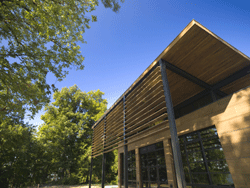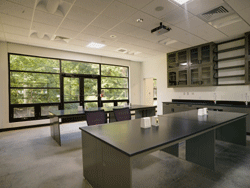April 3, 2009
VCU’s Rice Center Education Building becomes the first in Virginia to be awarded LEED Platinum Certification
Share this story
Video available at http://www.news.vcu.edu/for_media/ricecenter/ricecentervid.html.

Virginia Commonwealth University’s Walter L. Rice Education Building at the VCU Rice Center is the first building in Virginia to be awarded the U.S. Green Building Council’s LEED platinum certification, the highest sustainability rating possible.
LEED, which stands for Leadership in Energy and Environmental Design, is the council’s leading rating system for designing and constructing the world’s greenest, most energy efficient and high-performing buildings.
The $2.6 million education building opened last October at the Rice Center, VCU’s 343-acre living laboratory on the James River southeast of Richmond in Charles City County, and houses lecture and laboratory rooms for classes, a conference room and administrative offices. The 4,900-square-foot building features sustainable strategies for efficient energy use, lighting, water and material use.
“The sustainable features of the building not only reduce our impact on the environment, but also will be directly incorporated into our environmental education programs at the K through 12 and university levels, further increasing the public's awareness and understanding of environmental issues,” said Leonard Smock, Ph.D., chair of VCU’s Department of Biology and director of the Rice Center.

LEED certification of the building was based on a number of green design and construction features that positively impact the project itself and the broader community, including rain gardens to collect and treat storm water runoff and a vegetated roof system to reduce heat island effect and storm water runoff.
Energy usage is reduced through geothermal heating and cooling; high efficiency lighting; and high insulation levels that rely on soy-based products and recycled denim.
The building promotes efficient water use through dual flush and power assist toilets that operate with rainwater collected in a series of cisterns. Pre-engineered, on-site wastewater treatment results in advanced, clear and odorless effluent infiltrated into nearby wooded areas.
Rapidly renewable products were featured in construction, including sorghum paneling, recycled steel and gypsum board. Seventy-five percent of the construction waste materials were diverted from landfills by recycling.
“While this is our first certification, it is the first of many, as we currently have five other projects under construction that we expect to receive LEED Certification,” said Brian Ohlinger, VCU’s associate vice president for facilities management. The Platinum Certification for this project reflects the great commitment that our Rice Center Board of Directors and the University's Board of Visitors place on sustainable design.”
LEED was established to promote sustainable building design and construction that protect and preserve resources while also making good economic sense.
“The green building movement offers an unprecedented opportunity to respond to the most-important challenges of our time, including global climate change, dependence on non-sustainable and expensive sources of energy and threats to human health,” said Rick Fedrizzi, President, CEO and Founding Chair, U.S. Green Building Council. “The work of innovative building projects such as the VCU Walter L. Rice Education Building is a fundamental driving force in the green building movement.”
The Walter L. Rice Education Building was dedicated in October 2008 and sits on the property that Rice’s widow, Inger Rice, donated to VCU in 2000. She donated $2 million for construction of the education building in 2007.
Subscribe to VCU News
Subscribe to VCU News at newsletter.vcu.edu and receive a selection of stories, videos, photos, news clips and event listings in your inbox.










